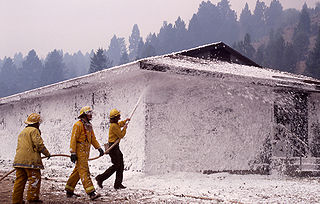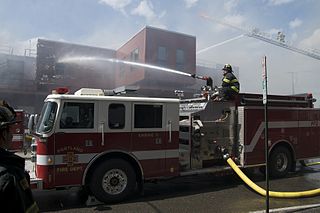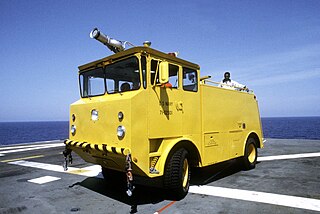
An air gun or airgun is a gun that fires projectiles using energy from compressed air or other gases that are mechanically pressurized. This is in contrast to a firearm, which fires projectiles using energy created by burning combustible propellants, i.e. gunpowder.

A fire hose is a high-pressure hose that carries water or other fire retardant to a fire to extinguish it. Outdoors, it attaches either to a fire engine, fire hydrant, or a portable fire pump. Indoors, it can permanently attach to a building's standpipe or plumbing system.

A fire sprinkler system is an active fire protection method, consisting of a water supply system, providing adequate pressure and flowrate to a water distribution piping system, onto which fire sprinklers are connected. Although historically only used in factories and large commercial buildings, systems for homes and small buildings are now available at a cost-effective price. Fire sprinkler systems are extensively used worldwide, with over 40 million sprinkler heads fitted each year. Even though Fire Sprinkler Systems are a Life Saving System and are not designed to protect the building, 96% of buildings that had fires and were completely protected by fire sprinkler systems were controlled by the fire sprinklers alone.

A nozzle is a device designed to control the direction or characteristics of a fluid flow as it exits an enclosed chamber or pipe.
A water gun is a type of toy gun designed to shoot jets of water. Similar to water balloons, the primary purpose of the toy is to soak another person in a recreational game such as water fight.

A scroll compressor is a device for compressing air or refrigerant. It is used in air conditioning equipment, as an automobile supercharger and as a vacuum pump. Many residential central heat pump and air conditioning systems and a few automotive air conditioning systems employ a scroll compressor instead of the more traditional rotary, reciprocating, and wobble-plate compressors.

A water tender is a type of firefighting apparatus that specialises in the transport of water from a water source to a fire scene. Water tenders are capable of drafting water from a stream, lake or hydrant.
This is a glossary of firefighting equipment.
Purple-K, also known as PKP, is a dry-chemical fire suppression agent used in some dry chemical fire extinguishers. It is the second most effective dry chemical in fighting class B fires after Monnex, and can be used against some energized electrical equipment fires. It has about 4–5 times more effectiveness against class B fires than carbon dioxide, and more than twice that of sodium bicarbonate. Some fire extinguishers are capable of operation in temperatures down to −54 °C or up to +49 °C. Dry chemical works by directly inhibiting the chemical chain reaction which forms one of the four sides of the fire tetrahedron. To a much smaller degree it also has a smothering effect by excluding oxygen from the fire. "Dry chemical" extinguishers, such as Purple-K, are different from "dry powder" extinguishers that are used to fight Class D flammable metal fires.

Firefighting foam is a foam used for fire suppression. Its role is to cool the fire and to coat the fuel, preventing its contact with oxygen, thus achieving suppression of the combustion. Firefighting foam was invented by the Russian engineer and chemist Aleksandr Loran in 1902.
Active fire protection (AFP) is an integral part of fire protection. AFP is characterized by items and/or systems, which require a certain amount of motion and response in order to work, contrary to passive fire protection.
A fire class is a system of categorizing fire with regard to the type of material and fuel for combustion. Class letters are often assigned to the different types of fire, but these differ between territories. There are separate standards for the United States, Europe, and Australia. This is used to determine the type of extinguishing agent that can be used for that fire class.

A compressed air foam system is used in firefighting to deliver fire retardant foam for the purpose of extinguishing a fire or protecting unburned areas. Allegedly.

An airport crash tender is a specialised fire engine designed for use in aircraft firefighting at aerodromes, airports, and military air bases.
A twin-agent fire extinguishing system (TAFES), also commonly referred to as a twin-agent unit (TAU), incorporates the benefits of dry chemical and foam fire extinguishing agents. It is most commonly used for AR-FF operations and in industrial areas with high class B hazards.

A deluge gun, fire monitor, master stream or deck gun is an aimable controllable high-capacity water jet used for manual firefighting or automatic fire protection systems. Deluge guns are often designed to accommodate foam which has been injected in the upstream piping.

A fire extinguisher is a handheld active fire protection device usually filled with a dry or wet chemical used to extinguish or control small fires, often in emergencies. It is not intended for use on an out-of-control fire, such as one which has reached the ceiling, endangers the user, or otherwise requires the equipment, personnel, resources, and/or expertise of a fire brigade. Typically, a fire extinguisher consists of a hand-held cylindrical pressure vessel containing an agent that can be discharged to extinguish a fire. Fire extinguishers manufactured with non-cylindrical pressure vessels also exist but are less common.

A booster pump is a machine which will increase the pressure of a fluid. They may be used with liquids or gases, but the construction details will vary depending on the fluid. A gas booster is similar to a gas compressor, but generally a simpler mechanism which often has only a single stage of compression, and is used to increase pressure of a gas already above ambient pressure. Two-stage boosters are also made. Boosters may be used for increasing gas pressure, transferring high pressure gas, charging gas cylinders and scavenging.

In fire classes, a Class B fire is a fire in flammable liquids or flammable gases, petroleum greases, tars, oils, oil-based paints, solvents, lacquers, or alcohols. For example, propane, natural gas, gasoline and kerosene fires are types of Class B fires. The use of lighter fluid on a charcoal grill, for example, creates a Class B fire. Some plastics are also Class B fire materials.

The Oshkosh MB-5 is a specialized aircraft rescue and firefighting (ARFF) vehicle built by Oshkosh Corporation for putting out fires on-board aircraft carriers. It was designed for rapid deployment of multiple firefighting media by a crew of 4, with a relatively compact design. However, What set this truck apart from other ARFF vehicles of the time was its ability to pump water while moving. This feature, along with its powerful 10.7 L Caterpillar diesel engine and four-wheel drive, made the MB-5 a staple of US military firefighting. It could be seen on US aircraft carriers and airbases both during and after the Vietnam War, continuing service for almost a decade after production of the truck stopped in late 1971 (unconfirmed).














